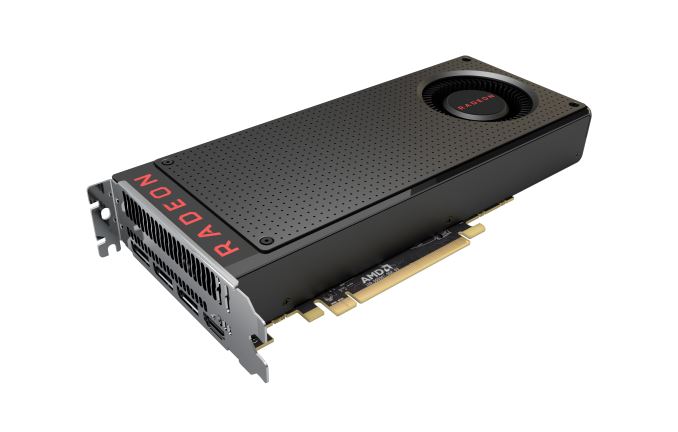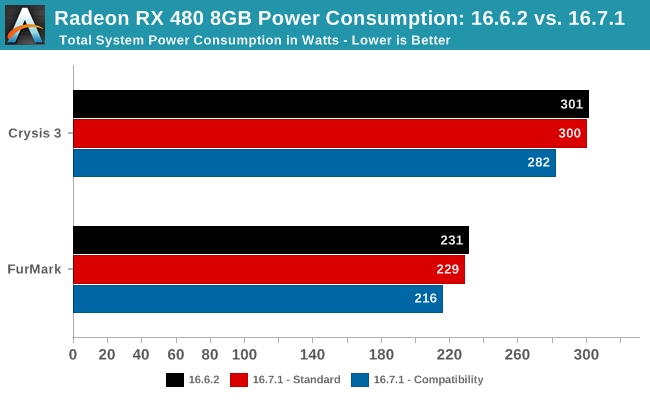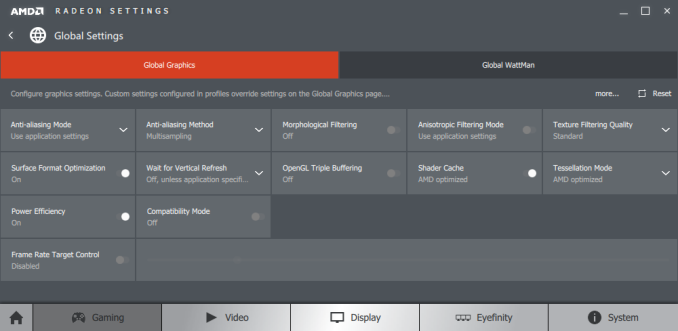AMD Posts Radeon 16.7.1 Drivers, Fixes RX 480 Power Consumption Issues
by Ryan Smith on July 7, 2016 6:50 PM EST
In what’s hopefully the final chapter on AMD’s saga over the last week with the Radeon RX 480’s power consumption, AMD has posted the previously promised 16.7.1 driver set on their website.
As a reminder, 16.7.1 is being released first and foremost to address RX 480’s power consumption issues, in which reviewers found that it was drawing too much power from the PCIe graphics (PEG) slot, and that the total power consumption of the card was at times exceeding 150W, which is the technical limit for a card with a 6-pin power connector. Of the two issues, PEG power consumption is arguably the greater of the two, as the external power connectors are far more forgiving.
To that end, 16.7.1 rolls out a two tier solution to the problem.
- Shift some of the power load off of the PCIe Graphics (PEG) slot connector in order to bring PEG slot power consumption within the PCIe spec. This doesn’t reduce total power consumption and performance is unaffected; power delivery is merely shifted. Based on earlier data this will put the 6-pin connector further over spec, but the vast majority of PSUs are very tolerant of this going out of spec.
- Because total power consumption of RX 480 can still exceed 150W – and as a result also exceed the limits for the 6-pin connector – AMD has also implemented an optional a “compatibility” toggle that reduces the total power consumption of the card. This is to better ensure that both the PEG slot and 6-pin power connector stay below their respective limits. Since the RX 480 is already throttling at times due to power limits, this does hurt performance (more on that below), but it's also the most standards-compliant solution.
Along with the power changes, the driver also incorporates some previously scheduled bug fixes and performance improvements. This includes fixing GTA V stuttering, and small performance boosts for a limited number of games that AMD states should improve performance by up to 3%.
Finally, the 16.7.1 driver can be found on AMD’s website. Note that the driver itself is not WHQL certified, but given AMD’s rush to get it out ASAP, I don’t imagine they were interested in waiting for WHQL certification to come back before releasing them.
Diving into matters then, PC Perspective has already taken a look at the new driver and done individual power rail measurements, finding that AMD’s fixes work more-or-less as advertised. They have found some edge cases where the card is still drawing a watt or two more power from the PEG slot than the specification allows, though at this point we’re arguing over inches. It should be noted however that even in compatibility mode, PC Perspective is still finding that power consumption is technically exceeding 75W on the 6-pin connector, though like the PEG slot by notably less than when not using compatibility mode.
Meanwhile to look at the performance impact of the new driver, I quickly ran our RX 480 through a selection of games at 2560x1440, both with and without compatibility mode.

In standard mode where power consumption isn’t curtailed, performance is essentially unchanged outside of Tomb Raider, which is one of the games targeted for optimization. Essentially this proves that there’s no performance impact from merely shifting power consumption off of the PEG slot to the 6-pin power connector.
Meanwhile in compatibility mode, there is a very small performance hit, though it varies with the game. Compared to standard mode, we’re looking at no more than a 1fps performance drop (~3%), with some games losing only a fraction of a frame per second. That there is a performance drop is consistent – so compatibility mode isn’t free – but overall the performance change is within the +/- 2% margin of error for these benchmarks.

Finally, when it comes to power consumption, measurements at the wall back up our earlier findings. In standard mode, power consumption at the wall bobbles by a couple of watts compared to the 16.6.2 drivers. With compatibility mode on, we see power consumption drop by 18W under Crysis 3, and 13W under FurMark. The average GPU clockspeed in both cases is similarly reduced, with Crysis 3 shaving off around 50MHz.
Anyhow, we’ll have a bit more on the subject in next week’s full Radeon RX 480 review. But in the meantime it looks like AMD has been able to get a handle on their power problems and largely rectify them within the span of a week, making for a fairly quick recovery on the RX 480’s launch fumble.











105 Comments
View All Comments
fanofanand - Friday, July 8, 2016 - link
Several years ago they did. :Pwatzupken - Friday, July 8, 2016 - link
I think its possible for a higher clock with an 8 pin power. However, I feel the chip is not meant to be operate at high frequency like those from Nvidia. The result could be an exponential increase in power requirement as well as heat output if overclocked hard.zodiacfml - Friday, July 8, 2016 - link
Seems AMD went out of their way to provide the 480 the best possible performance for the price. I'm afraid that the GTX 1060 will trounce this in performance and efficiency. The question would be if the $50 premium of the Nvidia is worth it over this.I reckon the Nvidia has more value on smaller enclosures.
Anato - Friday, July 8, 2016 - link
How is return current distributed? Voltage regulation is in positive side and they can change distribution like they did, but I can't see how they could change return currents to ground. And I doubt no one is measuring that.Although there is ample ground connectivity in 16x PCI-E, is it allowed to push more than 5.5A to motherboard?
miribus - Friday, July 8, 2016 - link
Their VRM is specifically designed to shift load sources, they can apparently update the ratio via driver.Anato - Saturday, July 9, 2016 - link
Y that part I know. Basically there is 12V source -> VRM 0.8-1.5V -> Chip & RAM -> Ground. There is nothing between Chip and Ground. This is of course bit simplified, there is connections to bypass capacitors etc, but they don't affect return currents. As 12V feeds total of around 14A in it has to have 14A ground connection too and I don't think they can distribute ground currents with their design. Chip VRMs likely (certainly) feed one pool of chip voltage.In 16x PCI-E there is >60 ground connections. If these are rated around same as +12V you could sink >60A to 16x PCI-E 8). But I don't think this is allowed by standard and most certainly would fry something from motherboard.
extide - Friday, July 8, 2016 - link
There are 6 phases to the GPU, 3 connected to PCIe slot, 3 connected to PEG connector. I am not exactly sure how the card is grounded, it could have a one big common ground, which is what I would expect, so this wouldn't be an issue. OR the phase's grounds could be connected to the same as where they are getting power (ie the 3 phases getting +12v from the PCIe are also grounded there, and the other 3 phases are grounded at PEG connector)They change the ratios by changing the duty cycles between the first 3 and the latter 3 phases. It would be cool to hook up a scope to those phases and you could see it.
Archie2085 - Friday, July 8, 2016 - link
@Ryan. There is lot of news about 480 performing upto 5% better with lower voltage of 1.050v and on the plus side reporting 30w Saving compared to stock voltage.. Looks like Leakage is High with higher temps/ higher voltage?? Can you please test it with the full review ..?RBFL - Sunday, July 10, 2016 - link
I have an RX480 8GB which stock runs 1.075 at the maximum state. Running Passmark graphics test, driven by an i7, it peaked at 110W and typically ran at around 100W.BrokenCrayons - Friday, July 8, 2016 - link
This is one of those "eh, whatever" things that simply doesn't matter to me. I think the only point worth noting is that shedding ~19 watts of consumption results in an insignificant performance drop. It highlights that AMD is pushing Polaris pretty hard to wring everything they can out of it and that lower end cards that don't get as much attention and aren't clocked as high will probably do better in performance per watt. That's hopeful since the entire 14/16nm move has been rather disappointing so far from an electrical and heat perspective and that's been the case so far with BOTH of GPU companies. Here's to hoping low end and mobile parts are better in that regard.